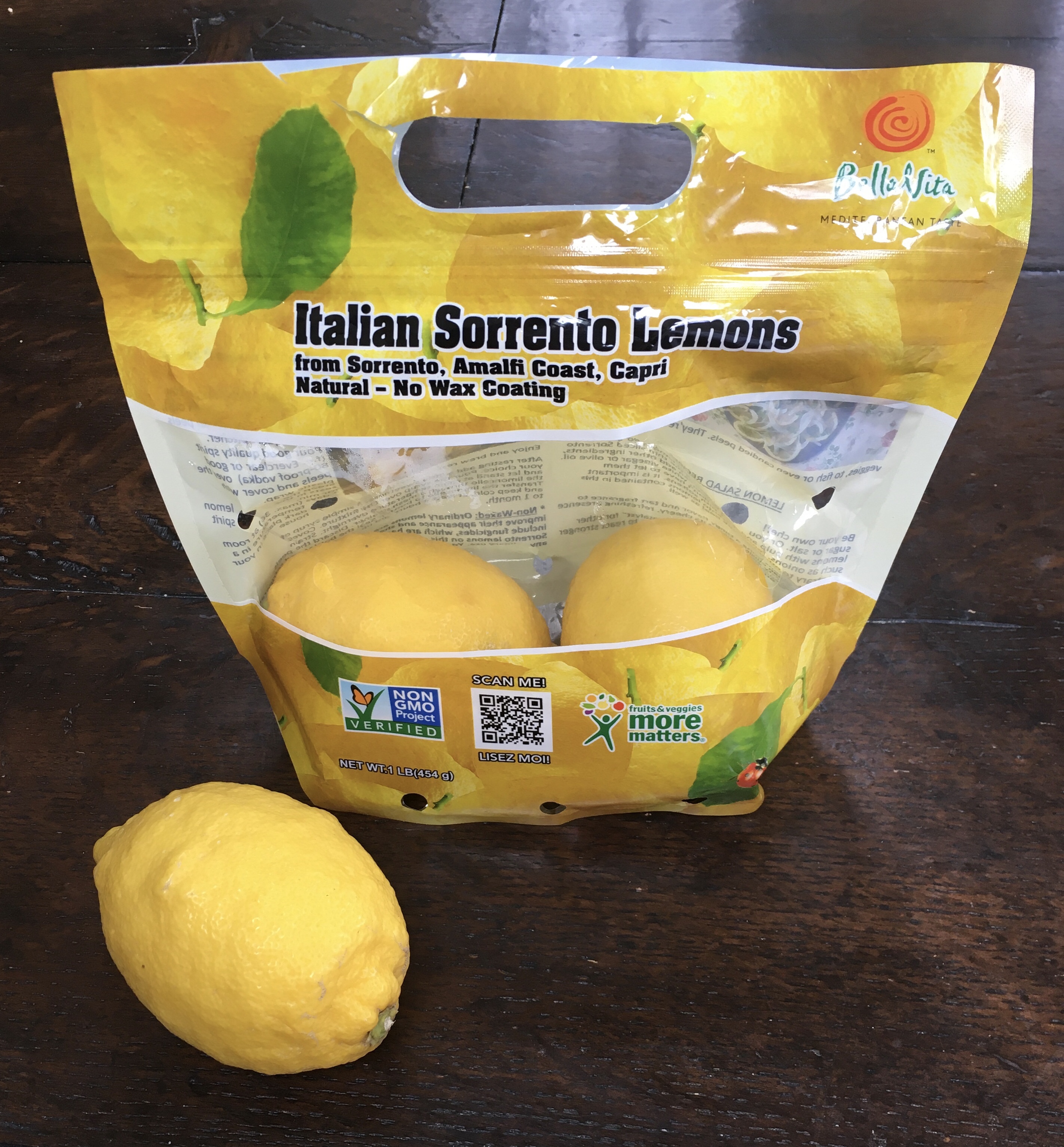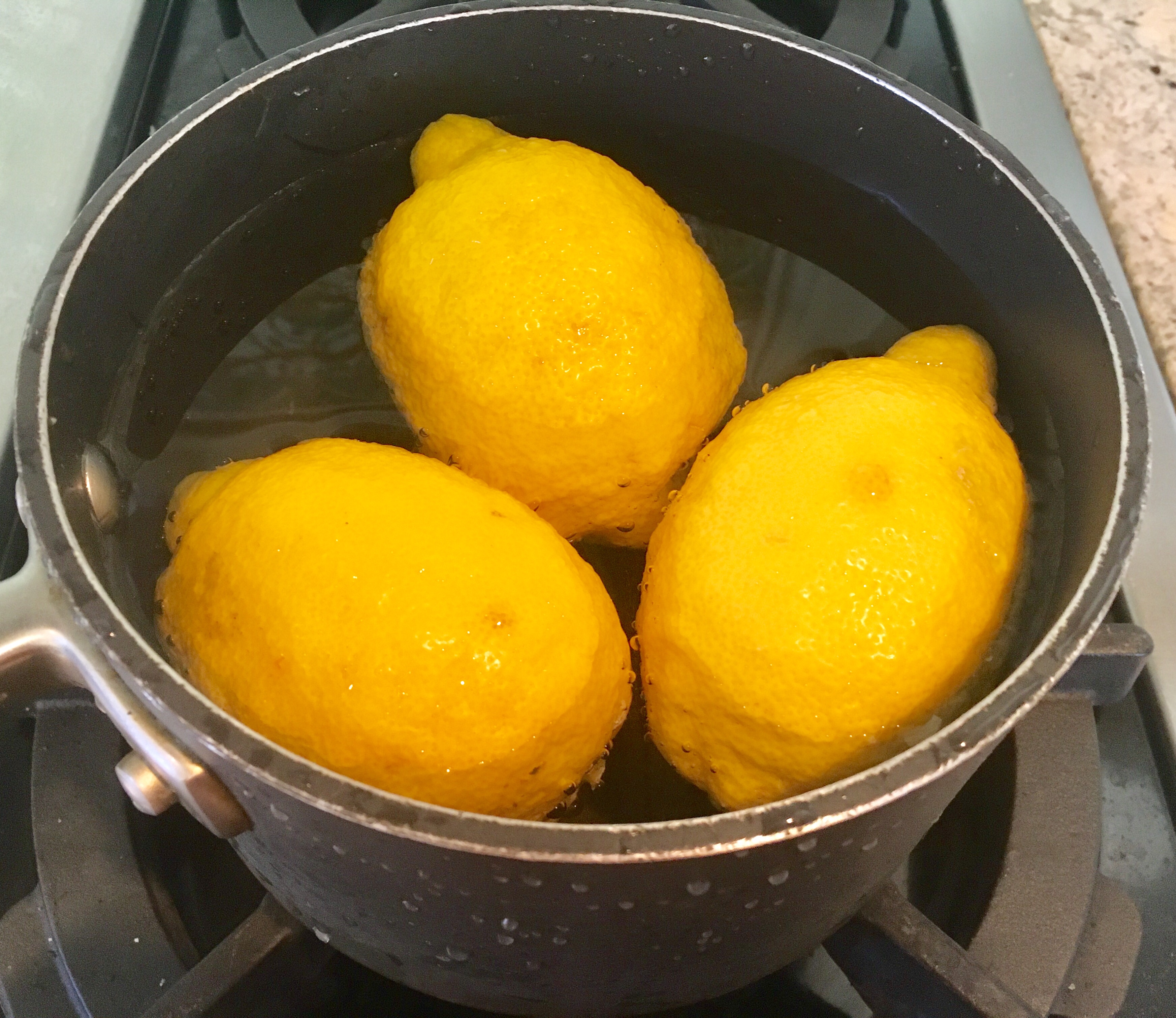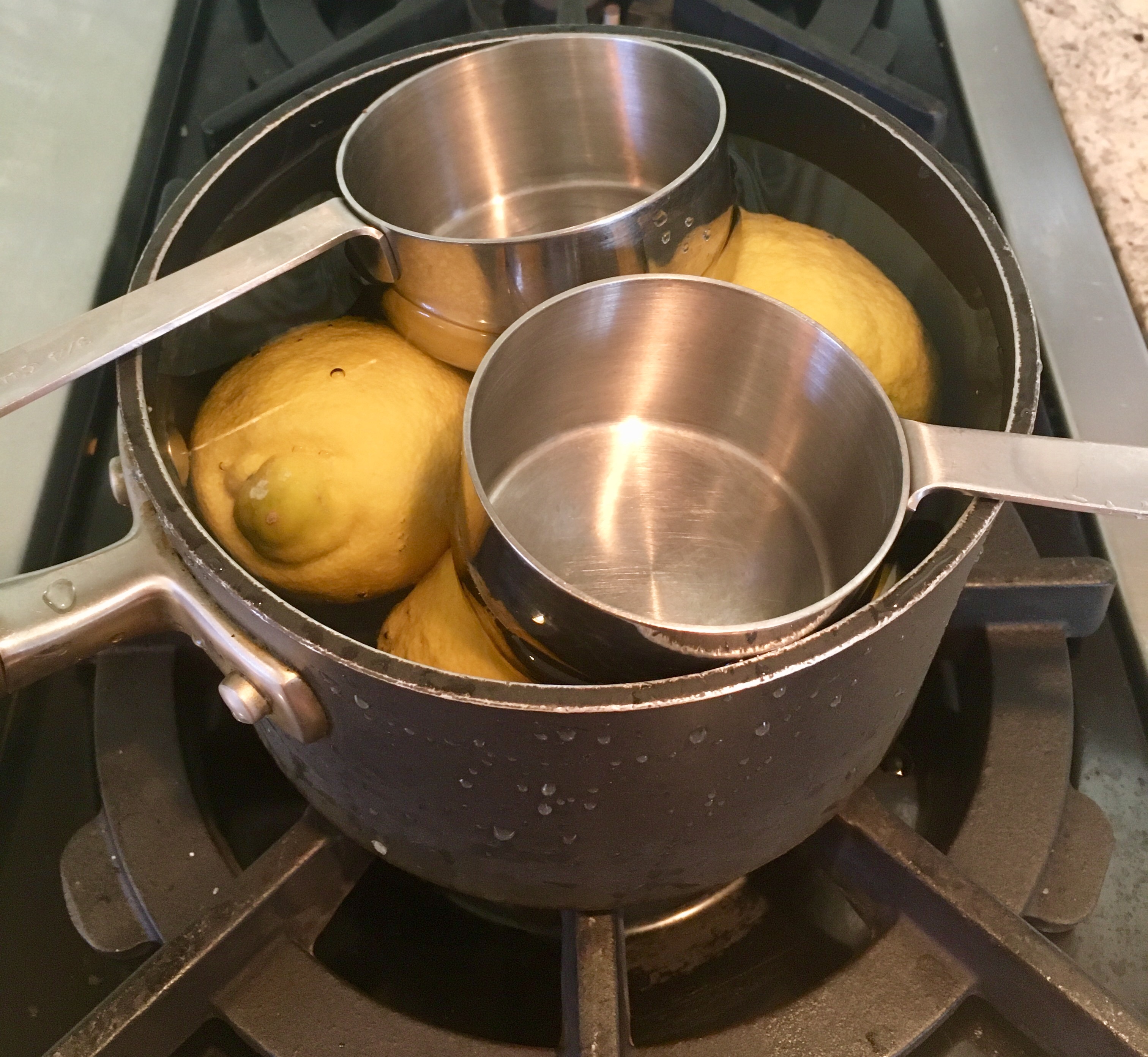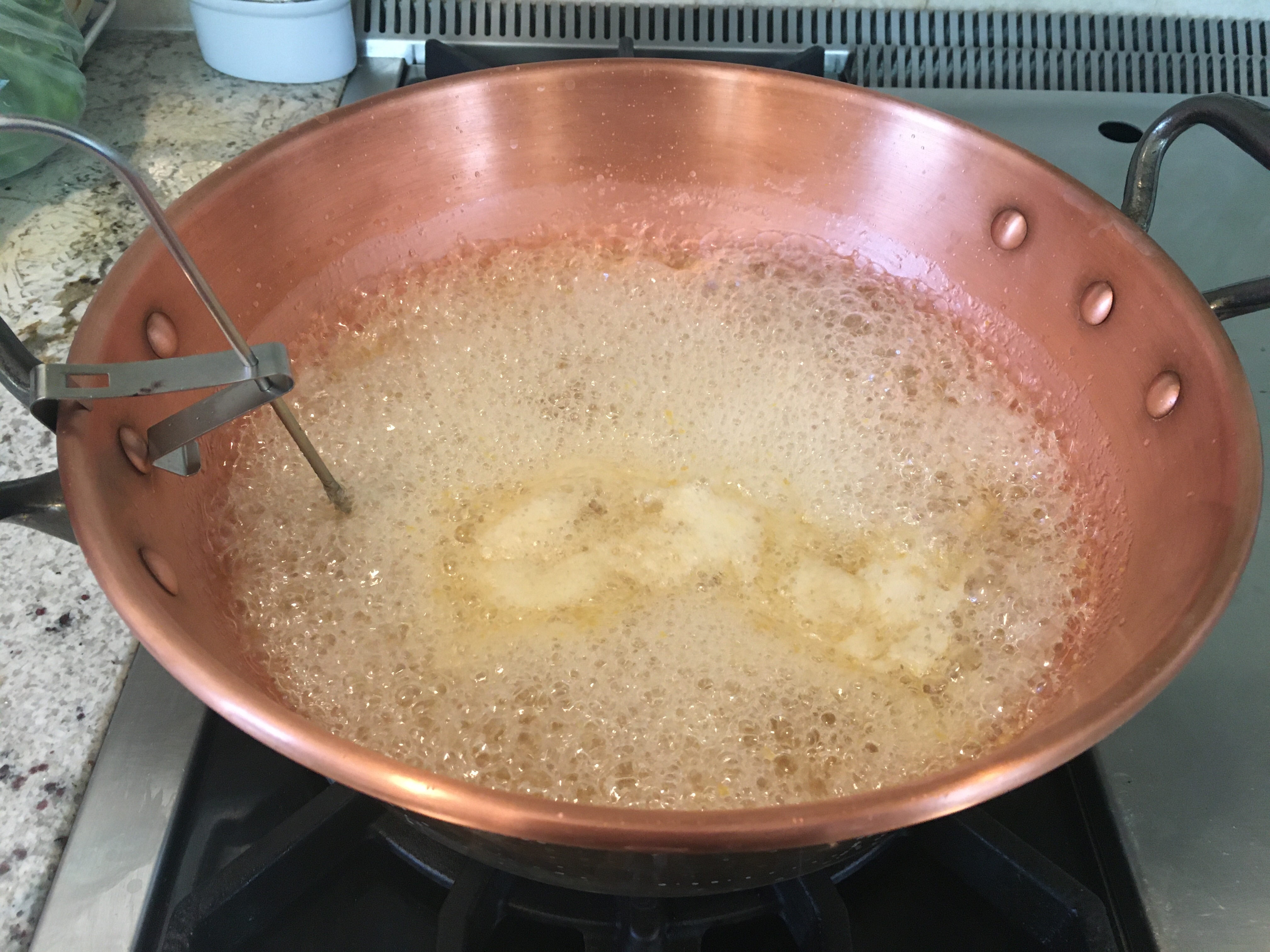Sorrento lemon marmalade
I’d like to share two easy ways to prepare lemon marmalade. Blanching or chopping peel by hand is not necessary.
I discovered the joy of Sorrento lemons in Sicily. They are used in lemon salads, Marmalade and fish. They have beautiful perfumed skin and juice with almost no bitterness in the skins. The first time I tried them I was smitten. Imagine my joy when I stumbled upon Sorrento Lemons imported from Italy at Whole Foods at the beginning of the Covid-19 confinement in Illinois. It was the last trip I took to the grocery store and I bought about 8 pound of lemons figuring I wouldn’t be back anytime soon. 
The two styles of whole fruit marmalade: Italian style English style. What is the difference? The Italian marmalade is more of a jam, thick and glossy but opaque. The English style has bits of peel suspended in a clear jelly. Keep in mind that for the most visually beautiful marmalade it is necessary to separate the peel from the rest of the lemon, supreme the segments and make a pectin bag with the seeds and membranes. It’s a lot more work.
So, I hope I inspire you to make some marmalade with these lovely Sorrento lemons. Just a bit of a warning, the classic ratio of fruit to sugar in marmalades is 1:2, one part fruit to two parts sugar, far more sugar than I would use for non citrus fruits. I have reduced the amount of sugar with the Sorrento lemons because they are not as bitter or tart as Seville oranges, grapefruit or standard lemons. My ratio is 1 part fruit to 1.5 parts sugar. I would advise against lowering the amount of sugar because it will take longer to gel and you’ll risk over cooking it and risk losing the fresh lemon flavor. If in the end it tastes too sweet you can always add a bit of citric acid or Eureka lemon juice.
Please read my page on preserving before you make this recipe. I go over cooking vessels, sterilizing jars, making a pectin bag and testing for gel.
INGREDIENTS FOR BOTH MARMALADES
- 1000 grams Sorrento Lemons
- 2000 grams of sugar
- 1500 grams water
- Pinch of salt
INSTRUCTIONS FOR ITALIAN STYLE MARMALATA
- Place the whole lemons in a pot whose bottom is big enough to hold them in one layer. Pour cold water in the pot until it just covers the lemons. Weigh them down with heavy measuring cups, a pot lid or cooling rack and bring the water to a boil.


- Reduce the water to a simmer and cook for 90 to 120 minutes until a fork can easily pierce the skin. Sugar will stiffen the peel so you want to make sure the skins are really soft.
- Take the lemons out of the water with a slotted spoon but save the water.
- Pick out any seeds you find and discard them. They’ve given up their pectin in the long simmering process.
- Chop the lemons. First, cut a slice of the stem end so it doesn’t wind up in your preserves. You have a few ways to chop the lemons. You can run them through a food mill with a disc that has the largest holes. That’s what I did with the jar I photographed and the method I prefer. You can use a food processor fitted with the blade and pulse it until you like the texture of the fruit. I find the food processor gives a less uniform texture than the food mill. You can cut them by hand in any shape you like. The thing to remember is that you need to use the whole lemon, juice, membranes, pulp and peel.
- Weigh the lemons and water and add enough water to equal the original weight of the lemons (In this case 1000 grams) before cooking them. So, in this instance, we started with a kilo of lemons so you want to add enough water so the total weight of the lemons and water is two kilos thereby keeping the ratio of 1:1.
- Add the 1500 gram of sugar.  So now you have one part lemon, one part water and one and a half parts sugar (based on the weight of the lemons). The reason I’m going in to such detail is one, I’m terrible at math and I’m sure there are others like me out there. Two, I want you to understand the ratios so that you can do this with any weight of fruit. Also, don’t be tempted to reduce the sugar. If you do, the acidity will be to high and you’ll develop free floating liquid in the marmalade once it’s cooled in the jars. This isn’t the worst thing as you can always stir it back to a homogeneous mixture but it also needs the amount of sugar specified to get the brightest yellow color. I’m putting this note in for myself as well. Last time I made these preserves I shorted the sugar by about 213 grams and the color was not as pretty and I got some free floating liquid in the preserves once they cooled. Oops! I need to do a better job following my own recipes.
- Add a pinch of salt and any herbs if you’re using them. Lavender and rosemary are both nice choices.

- At this point in the procedure, you can stop the process and stick the mixture in the fridge overnight.
- Sterilize your jars before you start boiling your preserves and stick a metal pan in the fridge for testing the gel.
- Bring the mixture to a hard boil in a pot that’s about double the size of the mixture as it will bubble up. Keep the hard boil going until it reaches about 215F. In the photo below, you’ll see a lot of bubbles and some opaque patches. That’s fine. I don’t skim. I think you just end up, skimming off pectin.

- Start testing the marmalade, making sure you take the pan off the heat while you’re testing so the mixture doesn’t continue to cook.
- I like a temperature of about 115-118F and if I’m being precise, I like it at 116F. At that temperature it’s thickened but still a bit loose. This takes around 5-10 minutes depending on what kind of a pan you’re using and how powerful your burners are. For me, 220F is too high and doesn’t taste as fresh.
- Fill your jars, once you’re happy with the gel. Insert the wooden skewer and jiggle it gently to eliminate air bubbles. Wipe the tops with your lint free towel moistened with hot water. Place the lids on the jars and tighten with you’re fingertips. Place on a rack to cool. The lids should pop in about 30 minutes. If you get one that doesn’t, just store it in the fridge.
INSTRUCTIONS FOR ENGLISH STYLE MARMALADE
- Cut lemons lengthwise in eighths and then crosswise into thin triangles.
- Weigh them and put them in a pot with an equal amount of water. The water should cover the fruit but if not, add more water.

- Cover and simmer until peels are tender, about an hour. Weigh the mixture and if some water has evaporated add enough so that the weight is back to what you started with. Add the sugar and salt and stir until the sugar dissolves.
- Bring the mixture to a hard boil and boil until gel stage.
- Let the mixture sit about a minute so the peel doesn’t float to the top when you fill your jars. if it does, once it’s poured, just redistribute the peel with your wooden skewer.
- Fill your sterilized jars, insert the wooden skewer and wiggle it to eliminate air bubbles, clean the rims with your moistened lint free towel, put on your tops, screw them shut with two fingers and set aside to cool.

Sorrento Lemon Marmalade, Italian and English
Variations:
I’ve done this with lemon and pear. I would recommend equal parts pear and lemon. The pears would have to be prepared separately with sugar, simmered , chilled and then combined with the lemons. I peel the pears and douse them in honey water to retard browning. I have a recipe for pear preserves on the website. If you look there you can see the way pears need to be prepared. I’d use a ratio of 1:1 pears and sugar and maintain the ratio of 1 part lemon to 1.5 parts sugar.
You can also do 1:1 lemon and strawberry
You can add almonds at the time you boil the marmalade.
© Julie de Lara and onemorebitedelara.com 2020
Hi, I would love to make this marmalata but the im not understanding the ratio of lemons to water. the ingredients state 1000g lemons 2000g water?
LikeLike
Hi Richard,
I amended the recipe as I have changed the ratios. Since the lemons are so acidic it’s best to use the classic ratios of 2 parts sugar to one part fruit. In this case, if you use 1000 grams of lemon you need 2000 grams of sugar. If you use less sugar two things happen, it takes longer to get to the set point which makes the flavor less bright and fresh, and after storing it for a while you can get some free floating water.
The amount of water is less important. You need enough to cover the lemons for the initial cooking. It will probably be around 1500 grams. At the end of the simmering of the lemons you will end up with less water and you’ll want to make sure that you have at least 5 cups or 1.5 liters of water. The reason the amount of water is not key is that it will evaporate with the cooking of the marmalade. If you cook it to 217-218F you will boil of less water than if you boil it to 221F. The temperature of the set point determines how much water is in the preserve. So it doesn’t really matter I’d you start with 6 cups or 5 cups of water. If you boil it to 217F you end up with the same amount of evaporation.
I don’t take any of preserves to 221F. I think it reduces the preserve too much and you lose the fresh flavor. I tend to go to 217F-218F. I’d rather get a looser gel and not sacrifice flavor.
Does that answer your questions? As I ask where your’e getting the lemons? Remember, this cannot be made with Eureka lemons from the supermarket. The pith is way too bitter and you’d have to do several blanching. For Meyer lemons I’d do a ratio of 1 part lemons to 1 part sugar to 1 part water.
If you have any other questions or my answer is not clear, please let me know.
LikeLike
Hello,
Thank you for the info.
I made the marmellata with eureka lemons . They were shipped from an organic farm in California. The lemons had a very small amount of pith. The ratio I used was 1:2. 500g lemons 1000g sugar and 500g water saved from boiling the lemons for 90 minutes. I removed the seeds then placed them into a food mill. Some of the skins just wouldn’t mill so I pulled them and chopped by hand. I cooked the ground Lemons, water and sugar for 20-25 minutes. I had a plate in the freezer for 15 minutes and did several wrinkle tests. Once done , the marmellata was put into hot mason jars and tightly closed the cap. This morning I enjoyed the marmellata di limone on homemade blueberry muffins. With an espresso… fantastic ! Thank you so much again for the details. I travel to Sicily several times a year. On my next visit, I plan to make a few jars using Sicilian lemons and take back home. If you were able to carry produce back, my extra bag with be full with fresh lemons and bergamot.
Regards Richard .
LikeLike
I’m so happy you liked the recipe! I don’t personally like using Eureka Lemons as the pith is so bitter and need to be blanched several times, which diminishes the flavor. I’m glad you had success and found eurekas without a lot of pith. Try with Sorrento lemons when you are in Sicily. The skin is so saturated with lemon oil and of course there is no bitterness to the pith.
I’d love to try Bergamot one of these days. I just tried Yuzu and the are lovely for pith is little bitter but not too much so I use this same technique and don’t Blanche them.
LikeLike
I wake up every morning looking so forward to my prize jars of Sorrento lemon marmalade‼️❤️ 🍋 ❤️
LikeLiked by 1 person
I’m so glad you’re enjoying the marmalade.
LikeLike
The Serrento lemon was AMAZING!!!
LikeLiked by 1 person
The Sorrento lemon marmalade is to die for. Truly amazing! Unlike anything I have tasted
LikeLiked by 1 person
This marmalade just melts in your mouth. And I’ve never been a fan of marmalade because of the bitter aftertaste. Julie’s Sorrento lemon has NO bitterness; just tastes like sunshine. Wish I knew how to explain it better, but every spoonful leads to the next and before you know it you’re using the mouse-sized spatula to be sure the jar is empty!
LikeLiked by 1 person
Thanks for posting. Im so happy you liked it!
I was lucky to stumble upon these lemons, imported from Italy, at Whole Foods. I have since located two other sources that carry them: Baldor Foods on the East Coast and and Pearson Ranch in California that assures me they grow the lemons under the name Santa Teresa. Next year I’m going to try some more for marmalade.
LikeLiked by 1 person
This is my favorite preserve to date! The lemons were the perfect flavor!
LikeLiked by 1 person
Thanks you!
LikeLiked by 1 person